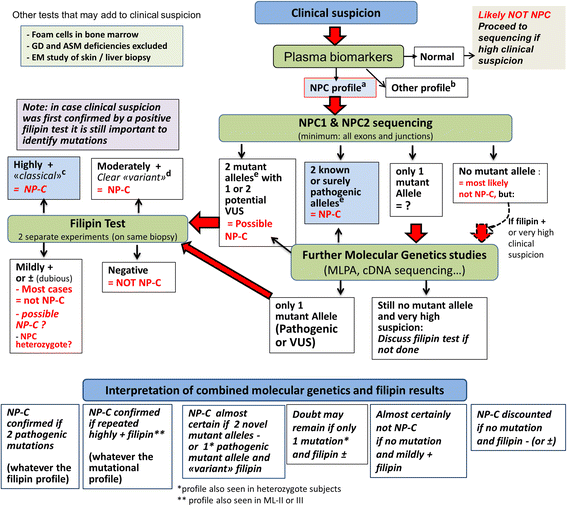Consensus clinical management guidelines for Niemann-Pick disease type C
- PMID: 29625568
- PMCID: PMC5889539
- DOI: 10.1186/s13023-018-0785-7
Consensus clinical management guidelines for Niemann-Pick disease type C
Abstract
Niemann-Pick Type C (NPC) is a progressive and life limiting autosomal recessive disorder caused by mutations in either the NPC1 or NPC2 gene. Mutations in these genes are associated with abnormal endosomal-lysosomal trafficking, resulting in the accumulation of multiple tissue specific lipids in the lysosomes. The clinical spectrum of NPC disease ranges from a neonatal rapidly progressive fatal disorder to an adult-onset chronic neurodegenerative disease. The age of onset of the first (beyond 3 months of life) neurological symptom may predict the severity of the disease and determines life expectancy.NPC has an estimated incidence of ~ 1: 100,000 and the rarity of the disease translate into misdiagnosis, delayed diagnosis and barriers to good care. For these reasons, we have developed clinical guidelines that define standard of care for NPC patients, foster shared care arrangements between expert centres and family physicians, and empower patients. The information contained in these guidelines was obtained through a systematic review of the literature and the experiences of the authors in their care of patients with NPC. We adopted the Appraisal of Guidelines for Research & Evaluation (AGREE II) system as method of choice for the guideline development process. We made a series of conclusive statements and scored them according to level of evidence, strengths of recommendations and expert opinions. These guidelines can inform care providers, care funders, patients and their carers of best practice of care for patients with NPC. In addition, these guidelines have identified gaps in the knowledge that must be filled by future research. It is anticipated that the implementation of these guidelines will lead to a step change in the quality of care for patients with NPC irrespective of their geographical location.
Keywords: Diagnosis; Guidelines; Management; NPC; Niemann-Pick Type C.
Conflict of interest statement
Ethics approval and consent to participate
Not applicable.
Consent for publication
Not applicable.
Competing interests
AD, BB,TH, YN, SJ, MW, DO, SS, PG, MS, UR, MTV and MP has received travel grant from Actelion. Shire has provided funding to YN, SJ, SS, MTV, AD, BB, MH and MP. Genzyme has provided funding to YN, SJ, SS, JI, MH and MP. Orphazyme has provided funding to JI, AD and BB. Alexion has provided funding to SS and MP. Vtesse has provided travel grants to MTV and MP. SS has received funding from Biomarin and Pfizer. MP has received funding from Agio, Amicus and Novartis. SJ has received funding from Biomarin, Ultragenyx, PTC and Orchard Theraputics.
Publisher’s Note
Springer Nature remains neutral with regard to jurisdictional claims in published maps and institutional affiliations.
Figures

References
Publication types
MeSH terms
Grants and funding
LinkOut - more resources
Full Text Sources
Other Literature Sources
Medical

